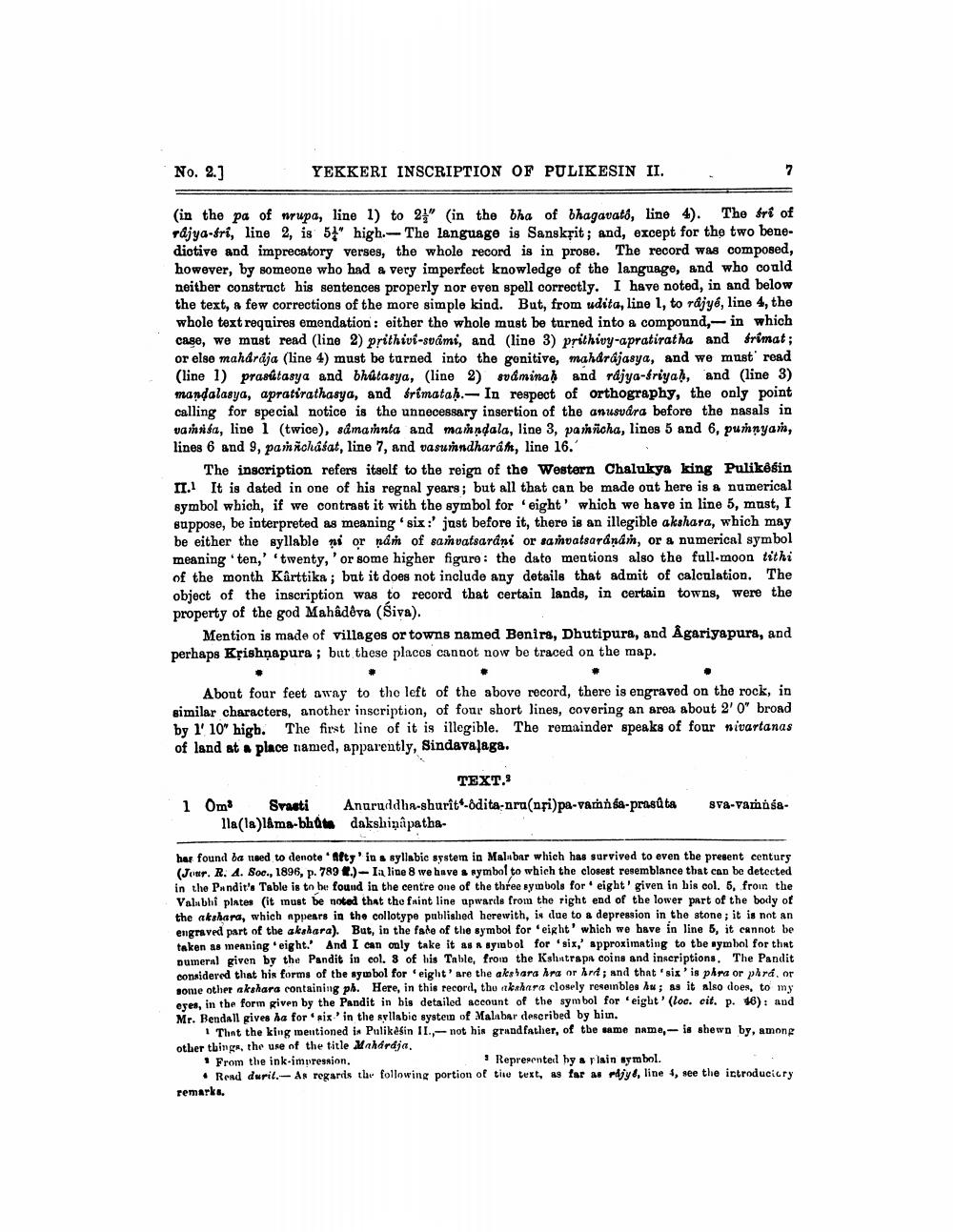________________
No. 2.]
YEKKERI INSCRIPTION OF PULIKESIN II.
(in the pa of wrupa, line 1) to 21" (in the bha of bhagavats, line 4). The fri of rajya-fri, line 2, is 5" high. The language is Sanskrit; and, except for the two benedictive and imprecatory verses, the whole record is in prose. The record was composed, however, by someone who had a very imperfect knowledge of the language, and who could neither construct his sentences properly nor even spell correctly. I have noted, in and below the text, a few corrections of the more simple kind. But, from udita, line 1, to rajyé, line 4, the whole text requires emendation: either the whole must be turned into a componnd, -in which case, we must read (line 2) prithivi-svami, and (line 3) prithivy-apratiratha and frimat; or else mahdrája (line 4) must be turned into the gonitive, mahdrajasya, and we must read (line 1) prasütasya and bhitasya, (line 2) svâminal and rdjya-friyah, and (line 3) mandalasya, apratirathasya, and frimatah. - In respect of orthography, the only point calling for special notice is the unnecessary insertion of the anusvára before the nasals in vannita, line 1 (twice), sdmannta and manndala, line 3, parhnoha, lines 5 and 6, pumnyam, lines 6 and 9, pamachásat, line 7, and vasunndharap, line 16.
The inscription refers itself to the reign of the Western Chalukya king Pulikesin II. It is dated in one of his regnal years; but all that can be made out here is a numerical symbol which, if we contrast it with the symbol for 'eight' which we have in line 5, mast, I suppose, be interpreted as meaning 'six:' just before it, there is an illegible akshara, which may be either the syllable ni or når of samvatsarani or samvatsaranam, or a numerical symbol meaning 'ten,' 'twenty,' or some higher figure : the date mentions also the full-moon tithi of the month Karttika ; but it does not include any details that admit of calculation. The object of the inscription was to record that certain lands, in certain towns, were the property of the god Mahadēva (Siva).
Mention is made of villagos or towns named Benira, Dhutipura, and Ågariyapura, and perhaps Krishnapura ; but these places cannot now be traced on the map.
Abont four feet away to the left of the above record, there is engraved on the rock, in similar characters, another inscription, of four short lines, covering an area about 2'0' broad by I' 10" high. The first line of it is illegible. The remainder speaks of four nivartanas of land at a place named, apparently, Sindavalaga.
1 Om Svasti
lla(a)låma-bhata
TEXT. Anuruddha-shurit -dita-nra(nri)pa-vannsa-prasata dakshinapath&
va-vamusa
har found ba need to denote 'Atty'in syllabic system in Malabar which has survived to even the present century (Joer. R. 4. Soc., 1896, p. 789 .)- la line 8 we have a symbol to which the closest resemblance that can be detected in the Pandit's Table is to be found in the centre one of the three symbols for eight' given in his col. 5, froin the Valabhi plates (it must be noted that the faint line upwards from the right end of the lower part of the body of the akshana, which appears in the collotype published herewith, is due to a depression in the stone; it is not an engraved part of the akshara). But, in the face of the symbol for eight' which we have in line 5, it cannot be taken as meaning eight.' And I can only take it as a symbol for 'six,' approximating to the symbol for that numeral given by the Pandit in col. 3 of his Table, from the Kshatrapa coins and inscriptions. The Pandit considered that his forms of the symbol for eight' are the akshara hra or hrd; and that 'six' is para or pard or some other akshara containing ph. Here, in this record, thu akshara closely reseinbles hu; ss it also does, to my oses, in the form given by the Pandit in bis detailed account of the symbol for 'eight' (loc. cit. p. 46): and Mr. Bendall gives ha forrix' in the syllabic system of Malabar described by hin.
That the king mentioned in Palikesin II.,- not his grandfather, of the same name,- is shewn by, among other things, the use of the title Mahardja. From the ink-impression.
Represented by a plain symbol. • Read durit.-as regards the following portion of the text, as far as adjy&, line , see the ictroducicry remarks.




